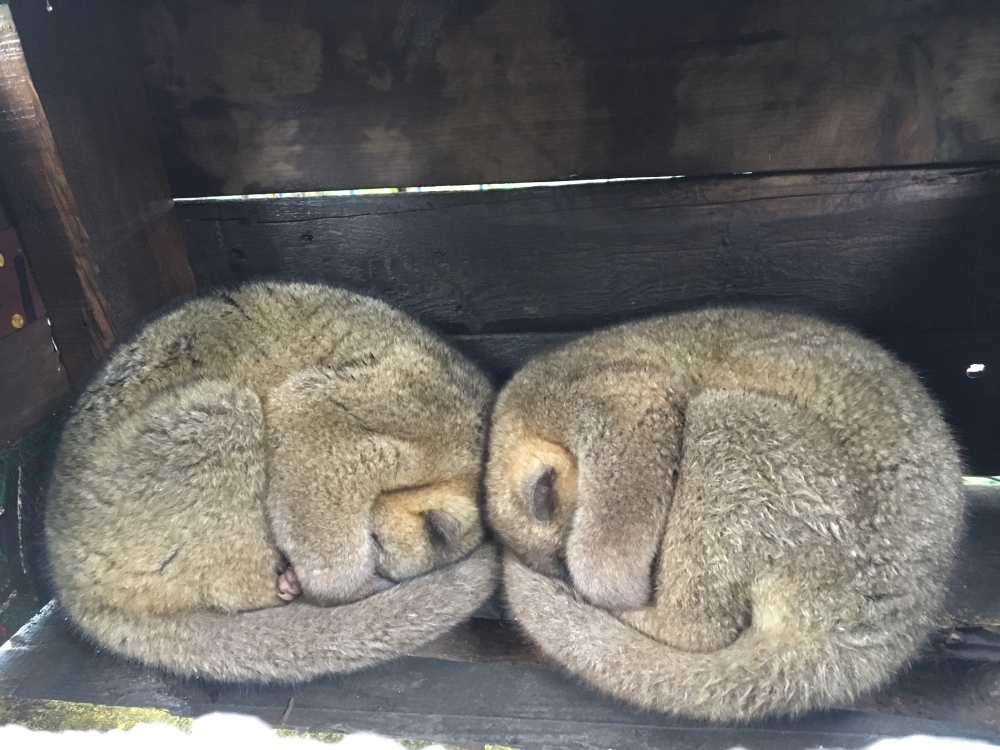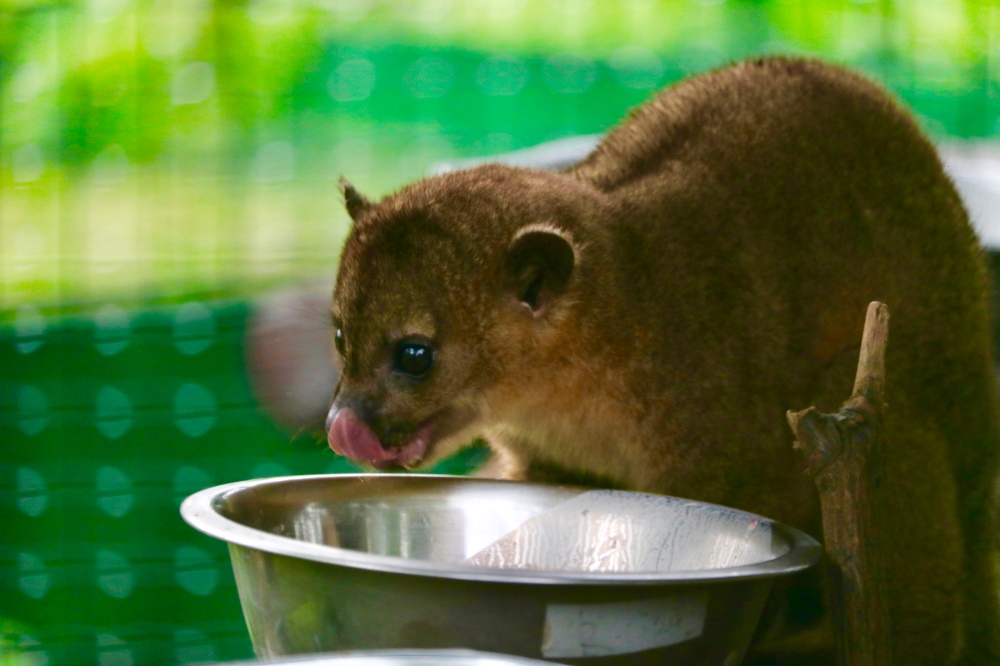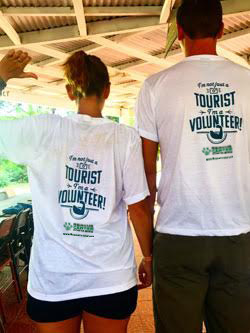
Most who have been following our journey will remember our previous volunteering trip in Peru which, unfortunately, did not provide as wholesome an experience as we were hoping for. We combed meticulously through rescue after rescue in Costa Rica, desperate to avoid another upsetting experience. We finally settled upon a centre next to the jungle near an unknown town, about an hour away from San José.
They kindly arranged a pick up for us from our hostel in the city. We sat nervously sipping coffee in silence as we speculated what waited for us. We pulled into the centre and were greeted by a British volunteer coordinator who had been there for 7 months. Good omen number one – long lasting volunteers!
She showed as around the huge property, from the many aviaries containing a smorgasbord of exotic birds, to the huge sky scraping enclosures that housed monkeys. We didn’t want to draw comparisons but it was hard not to, and everything we saw looked close to perfect.
Our tour finished at the on-site hospital where we met the full time vet who worked there, Andrés. Everyone seemed thrilled to have us on board, and we couldn’t hide our excitement as we discovered they had everything from an X-ray machine to ultrasound to a multi parameter to monitor patients under sedation or anaesthesia! The latter is often a luxury item in U.K. practices so we were particularly surprised to find it here. We crashed out for the night in dorm rooms, excited for what the next few weeks were to bring.
We spent our first few days rotating around the various animal teams on site before joining the vet team. This allowed us to experience all aspects of volunteering at the Rescue Centre, as well as seeing all the animals, as when we joined the vet team we unfortunately were fairly restricted to being in the hospital and nowhere else. The work was easy, involving cleaning out enclosures, providing enrichment and feeding all the animals on site.
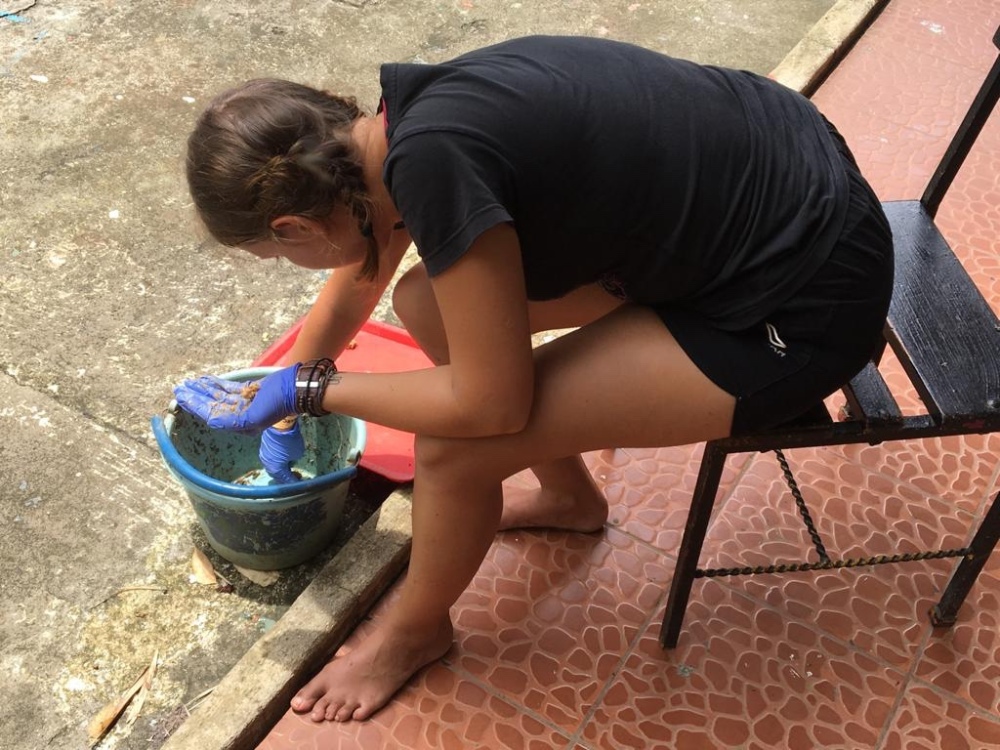

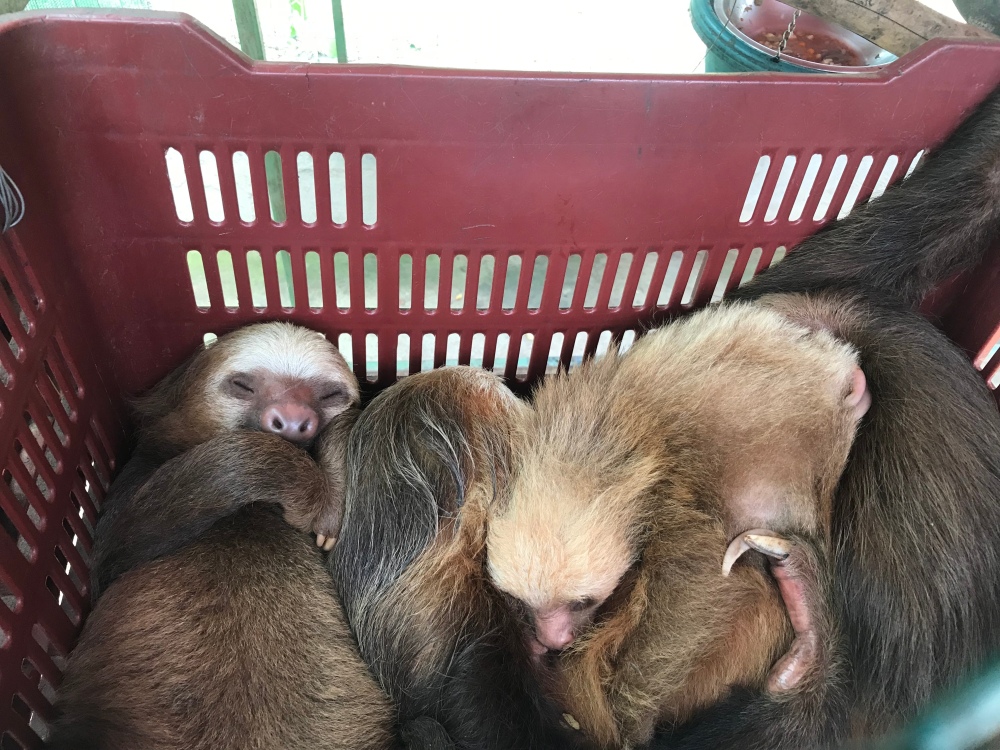
Once on the vet team however, our day became a lot more chaotic! We were a much smaller team of long term volunteers caring for the following:
2 adult owls
2 adult chachalacas
2 adult 3-toed sloths
5 adult 2-toed sloths plus 2 babies
2 newly arrived parrots in quarantine
1 adult gwan
1 adult coati
1 juvenile toucan
2 baby owls
4 baby coatis
1 baby raccoon
1 baby porcupine
1 opossum so small she was still pink
10 very young opossums
1 older opossum
5 baby birds of unknown species
Plus an ever changing number of opossums in an outdoor enclosure pending release
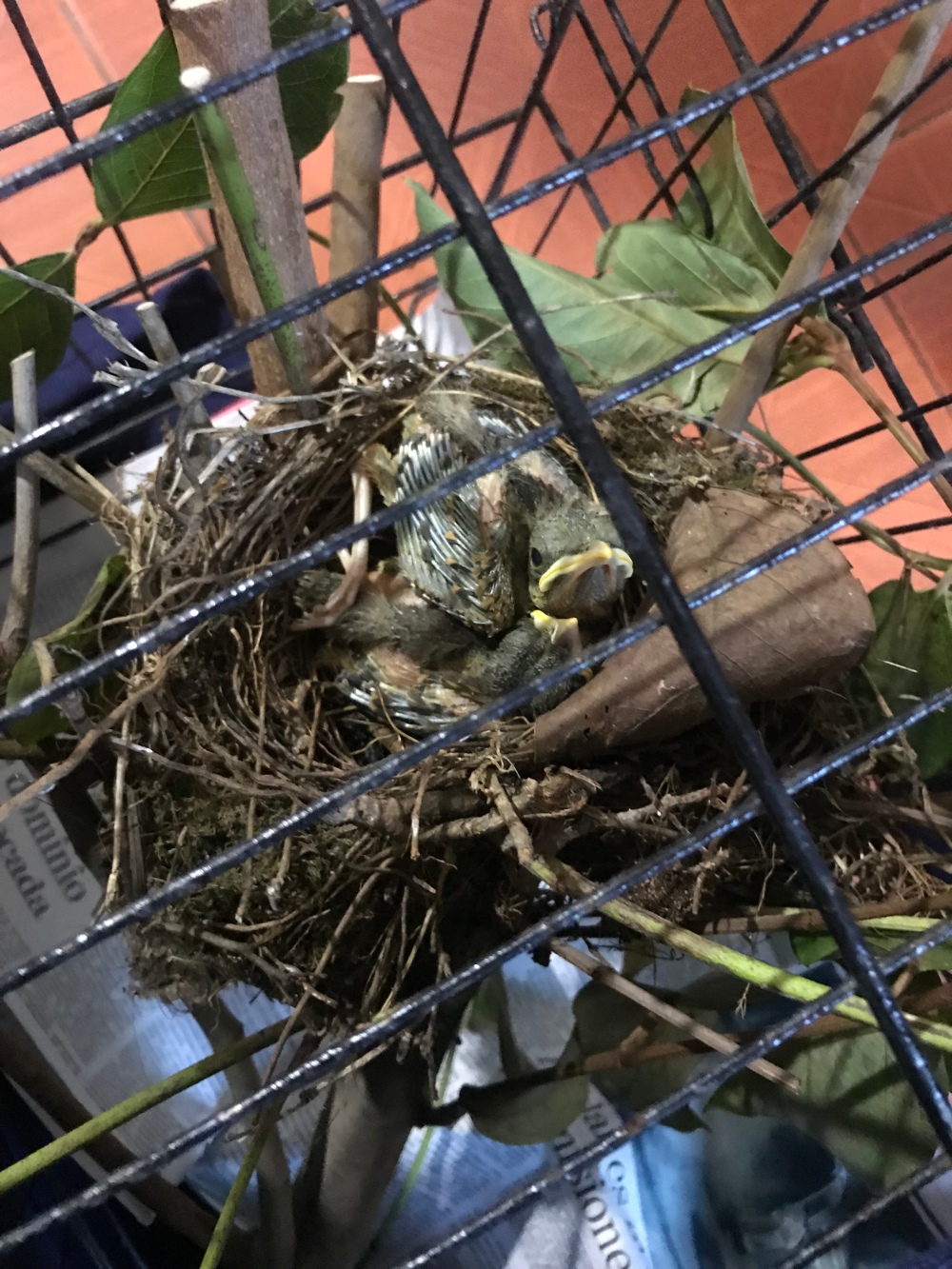
It was very busy. Here’s an idea of a typical day on the vet team:
7.30am – Breakfast
8am – Hand out pre-prepared food to animals
8.30am – Volunteer meeting
9am – Clean out all animals. This could be as easy as raking up old leaves and poo, or a much more involved affair as it was with the baby coatis as we had to remove them from the cage before hosing, scrubbing and disinfecting the cage as they make a horrendous mess!
11am – Feed female 3-toed sloths and babies. Also use this time to potentially administer any medications or treatments that may be required.
12pm – Lunch
1.30pm – Clean all enclosures again, this generally took less time than the morning.
3pm – Prepare meals for dusk and night feedings, as well as meals for the following morning.
4pm – Administer any medications, also use this time for any procedures such as sedations or examinations.
6pm – Dinner
8pm – Nocturnal feeds
12am – More nocturnal feeds
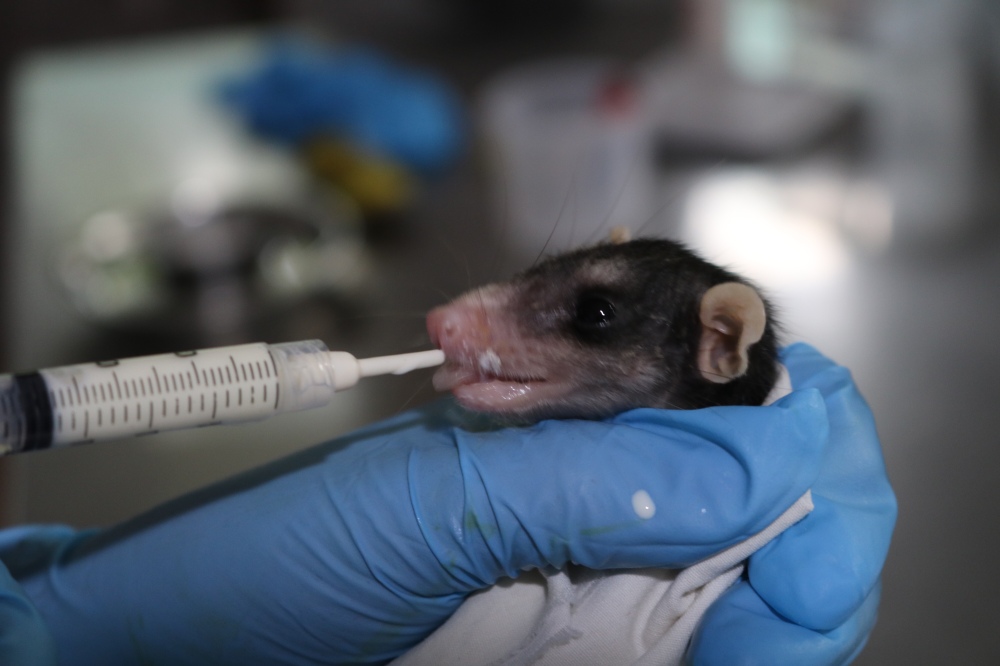
Oh and on top of all this? Those 10 opossums and the tiny neonatal opossum needed syringe feeding every 4 hours. It was round the clock work, and for someone who has difficulty with a disrupted sleep pattern it nearly killed me until I had a day off and pretty much just slept. At the end of this blog I’ve got some tips for those who may be interested in volunteering at the Rescue Centre and the first one will be: take your day off! You get one a week and it’s a day of your choice. We tried to not have a day off but after 17 days of this schedule we needed it!
Moving on to the stars of the show: the animals. This is going to be a long read, but we wanted to highlight all the animals at the centre as well as include loads of gorgeous photos of them!
The Birds
These were the first animals I cleaned and fed when we started at the Rescue Centre. I will openly admit I am not a “bird person”, but being around scarlet macaws is a pretty special experience. All the birds are pets that were being kept illegally so were seized and the owners punished. Almost all of them had their wings clipped, rendering them unable to fly so they are unable to be released, destined to a life in a cage because of selfish humans. Whilst the actual act of clipping a birds wings is not painful, it’s their primary mode of transport so is not an ethical practice.
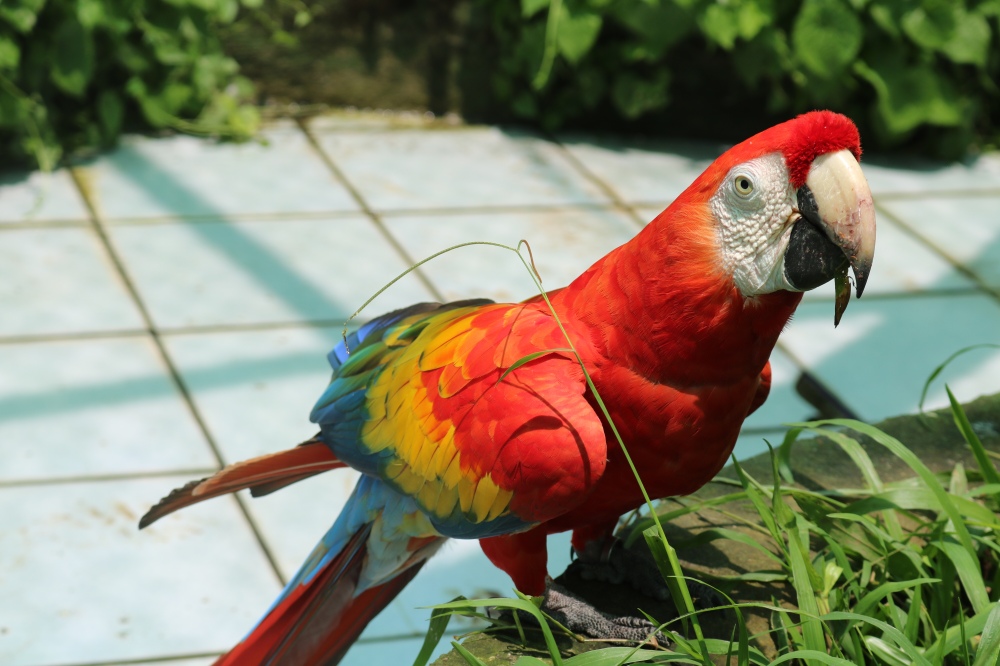
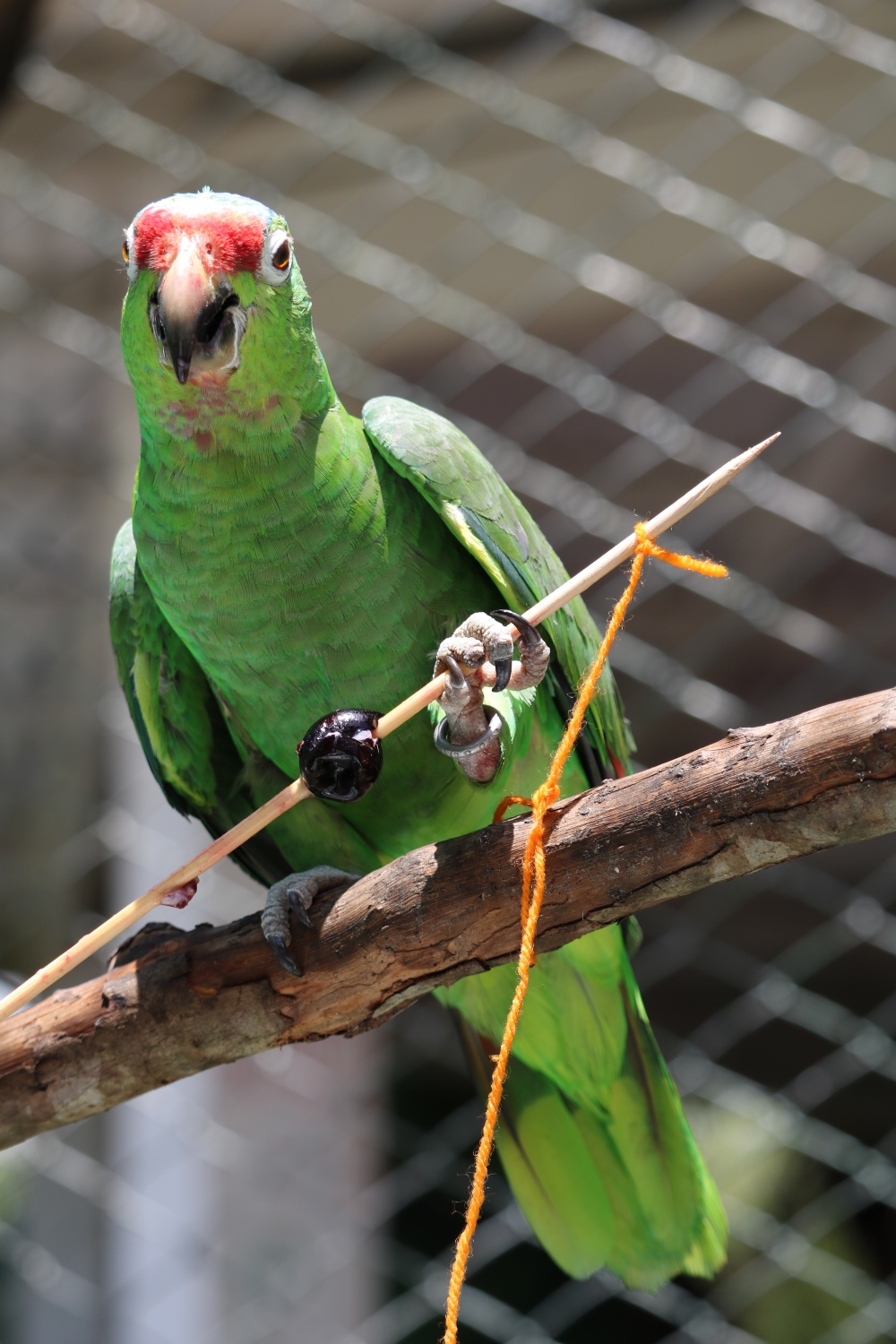
Despite not being able to fly the birds all actually seemed pretty happy. The multiple aviaries contained various dynamic relationships (mainly the macaws being bullies!) and you could always hear when it was kicking off, mixed with the sing-song of the mimicking green parrots nearby it made for an interesting background soundtrack to the Rescue Centre!
As part of the vet team we were tasked with monitoring different birds: owls. 2 adult spectacled owls, Hagrid and Merlin, sadly are unable to be released. They are too habitualised after being used previously in a magic show, plus one of them only has one wing so is unable to fly. We weighed and fed them mostly raw chicken…but one day they got a treat when a fer de lance was found on the property. The head was cut off the highly venomous snake and the body left for them to feast on. Yum!
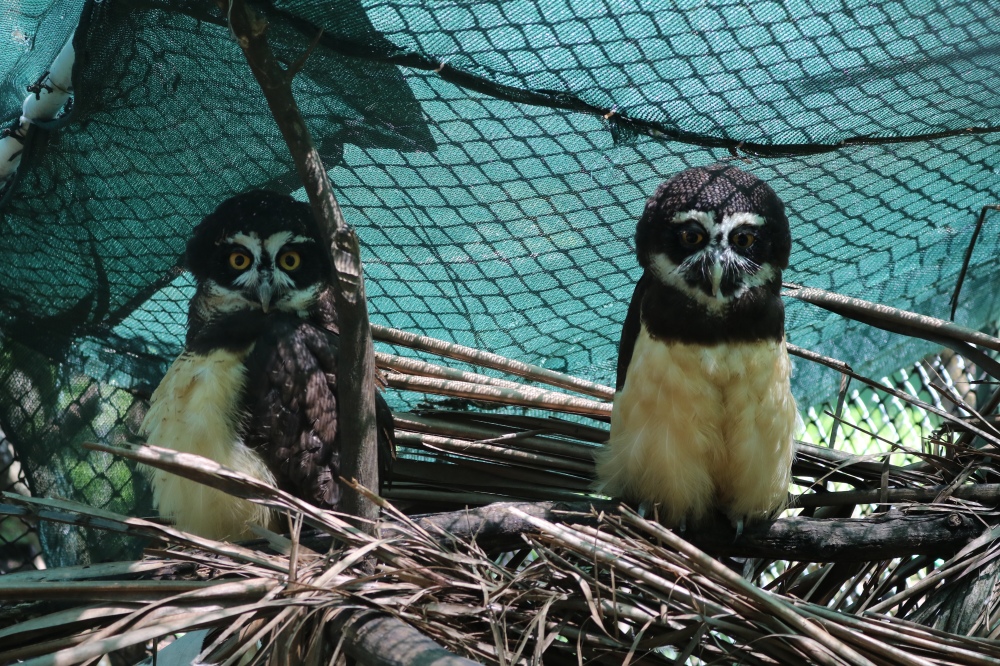
There was a release in sight for the 2 younger spotted owls Cinnabon and Gizmo.
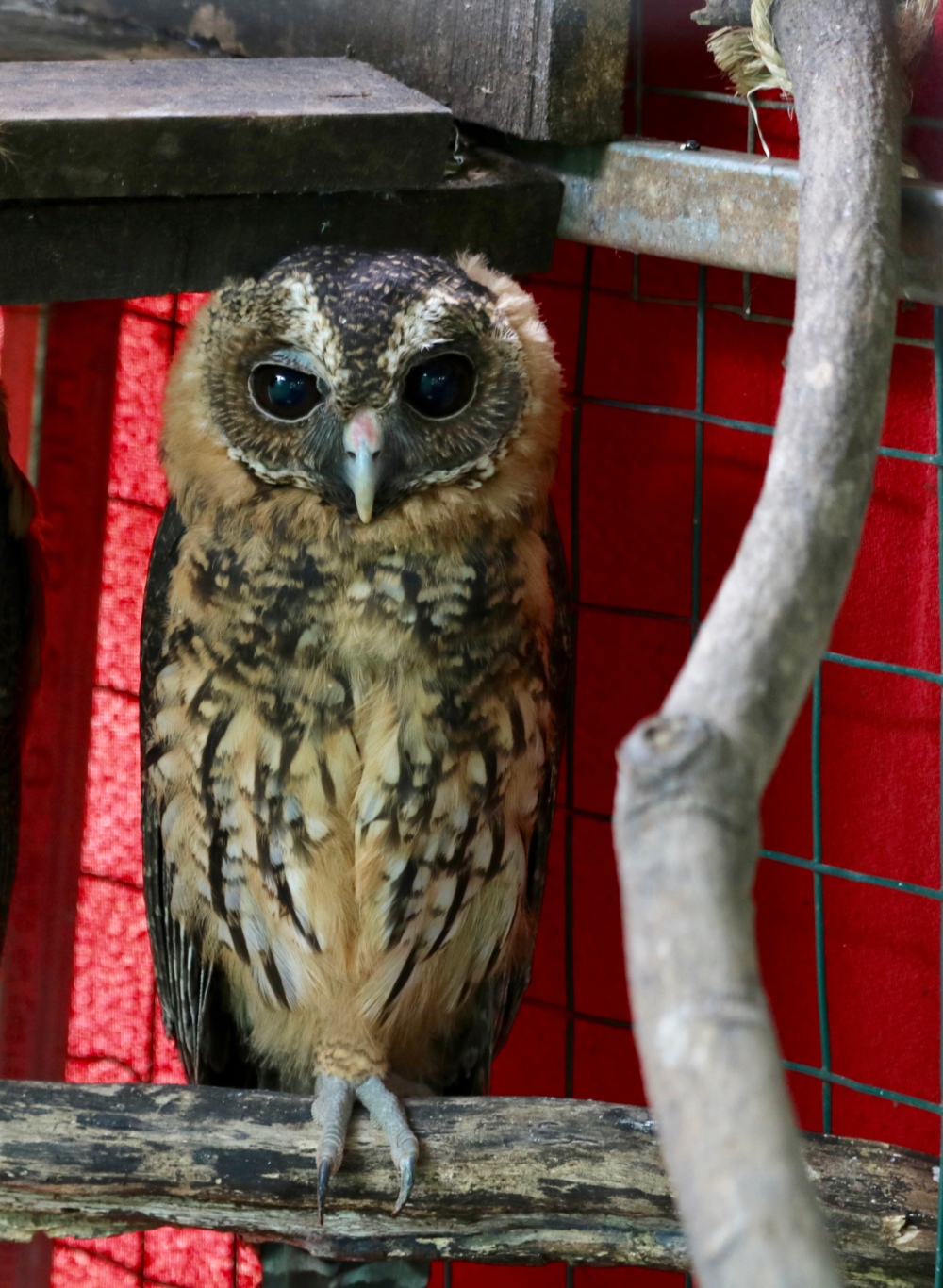
Being smaller they were fed at dusk and in the middle of the night, and to prepare them for release we did not want them to associate humans with food. How do you do that? With this highly technical hood:

The last bird destined for release is Zazu the toucan. He was found in the road, unable to fly and was having trouble gripping with one claw. With time and some good nutrition he was both growing and improving, soon flying from branch to branch in his enclosure, his grip improving he and his attitude worsening. I feel like he hated me! I would put a bowl of fresh fruit and insect pellets in his enclosure and he would grab my arm with his enormous beak. It didn’t hurt but I could feel the potential power he had, especially when he would grip and shake my arm like a dog with a toy. On one occasion I had half my body in his cage cleaning it out and he grabbed my head with his beak! How and why people have these birds as pets is beyond me. Luckily for Zazu his future in the wild will become a reality soon.
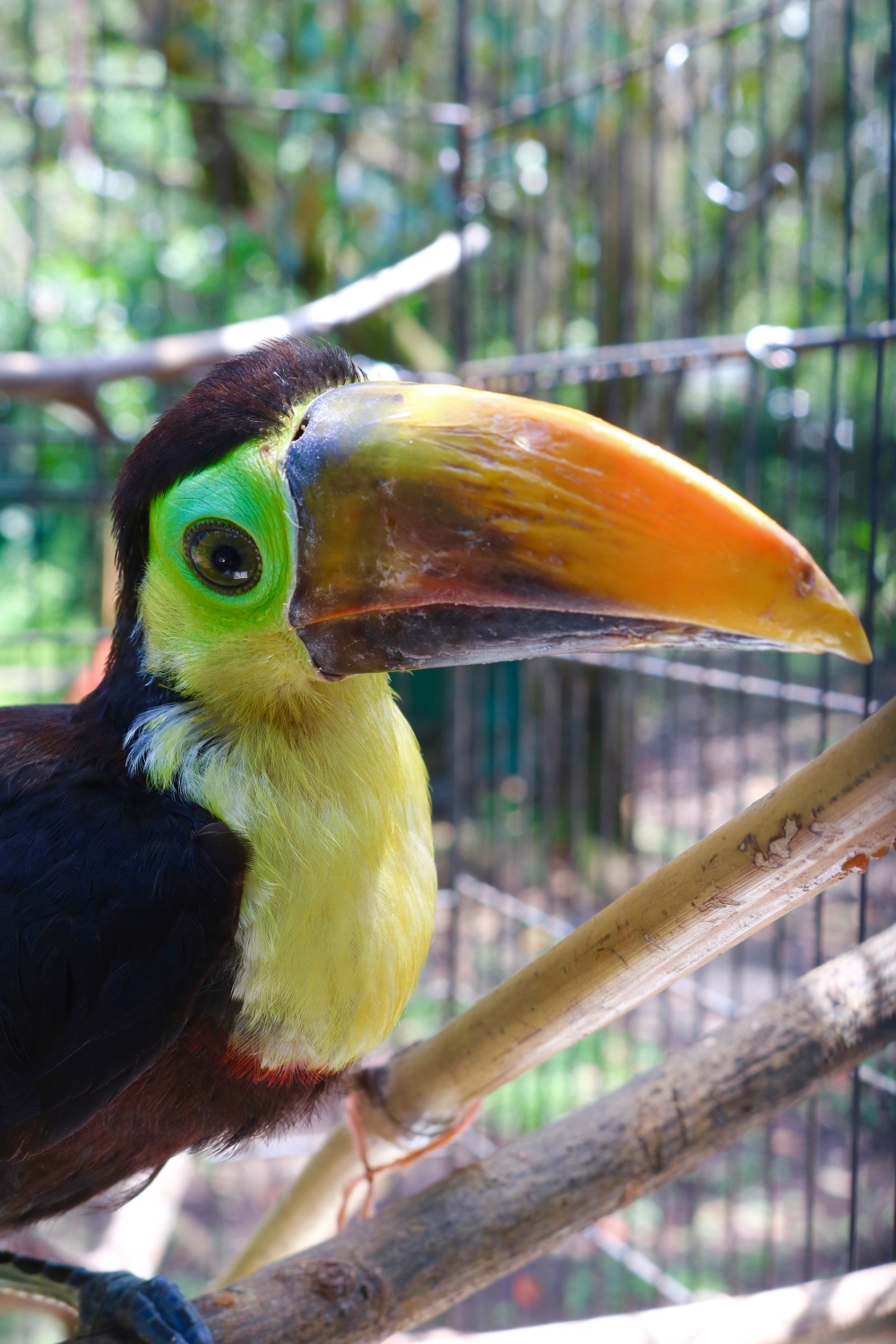
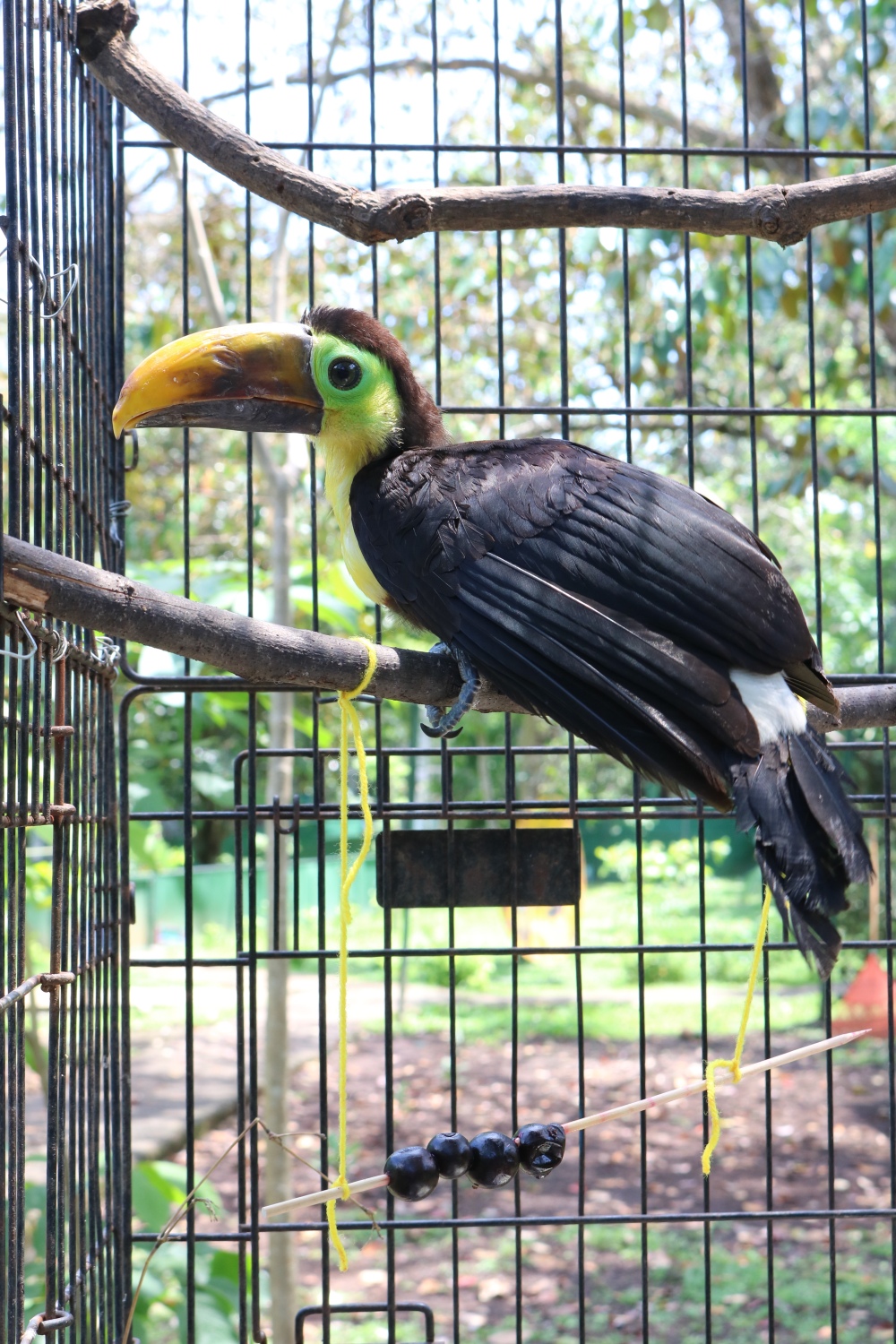
The Opossums
Of all the animals to become so attached to we were not expecting opossums to be one of them. There are several species of opossum found in South and Central America, the common opossum being, well, the most common! They can grow to the size of a cat, which is hard to believe when we were feeding ones that were so tiny! At such a young age they required milk (we were giving them squirrel milk!) at regular intervals, and much like neonatal puppies and kittens that we have hand reared in our careers they need help going to the toilet. So for each opossum we had to warm up milk, slowly syringe feed them ensuring they swallow every drop and do not aspirate any, then using cotton wool dipped in warm water we had mimic a licking motion to stimulate them to pass urine or faeces. It’s a lengthy process, now imagine you have to do this 11 times and every 4 hours throughout the day. We recruited all the volunteers to help us, and “opossum parties” would kick off where the hospital filled with bodies, each holding an opossum and getting to know there little personalities. It was a fantastic, unifying thing to experience.
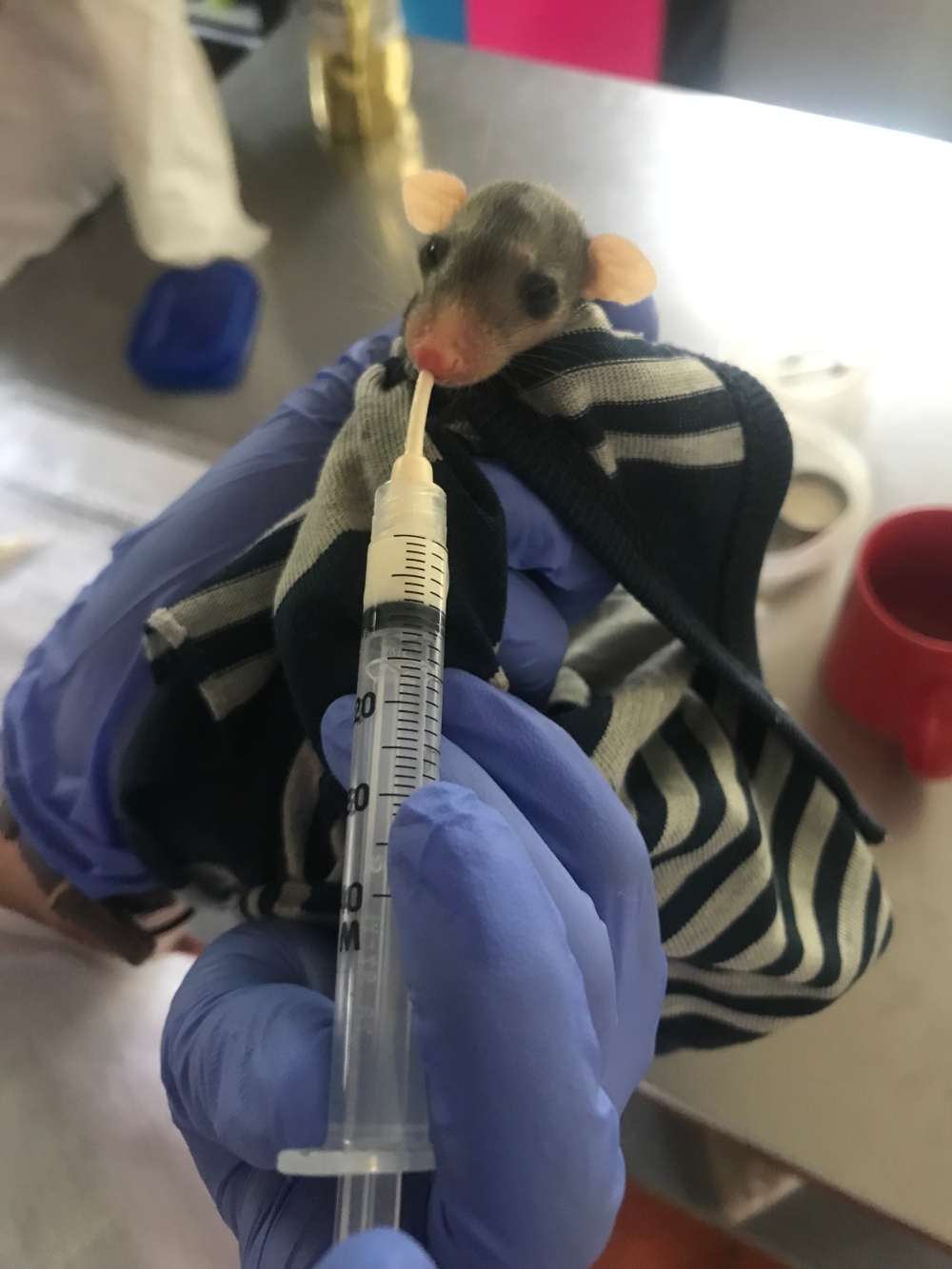

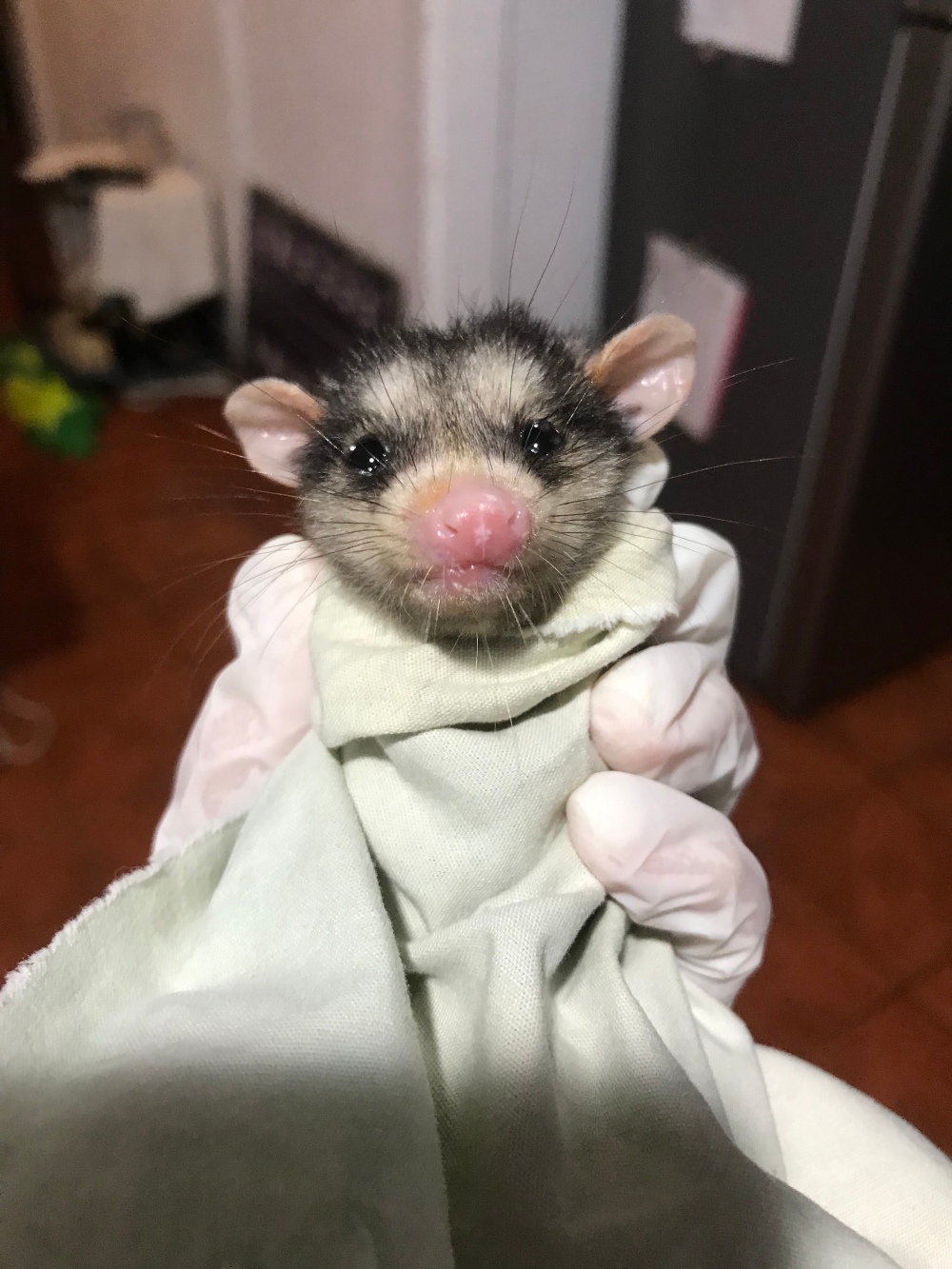
Sadly hand rearing does come with its downside. Opossums have quite large litters, and in the wild it would be rare for all of them to survive. So when we received a litter of 7 pulled from the pouch of an opossum that had been killed a dog we weren’t surprised when 2 passed away within a few days of arrival. After a few days they seemed to be doing well but not gaining weight, so we added a high calorific mix to their feed. This did the trick, but one we named Poppet began to fade, losing her appetite and becoming weak. She passed away the next morning, breaking the hearts of every volunteer that had been fighting to keep her alive.
Next was Pippin, then Pedro, a post mortem was performed on each one and whilst we were relieved that there was no evidence of aspiration (milk on the lungs) each opossum had unusual looking gut or liver. Something wasn’t right with this litter, but it didn’t make it any easier, especially as they had started eating some solid food and seemed to be doing well. After we had left the centre the remaining 2 had passed. Not one of the litter survived. We all tried our hardest, and they had a better chance with us than they did in the wild, but it was soul destroying.
So on to happier opossum times. A member of the public brought in a larger young opossum that seemed to be having trouble walking. His legs were malformed, it almost looked like he had rickets, so Andrés determined he had not been found like that, rather someone had tried to raise him as a pet and fed him a diet lacking in nutrients so his bones had not formed correctly. Shanon named him David (as in Bowie, because of his bowed legs) and quickly became attached to him as he was so ugly he was almost cute. We watched him wriggle across the floor, unsure if he would be able to live a normal life. Andrés agreed to give him a week to see if he would improve.

Shanon took David under his wing, feeding him lots of meat, egg and cat food regularly to increase his protein and calcium levels. He would get him out daily and move his legs in a strange form of opossum physio therapy, and within a week we actually saw an improvement. He went from wriggling in his belly to shuffling himself with his legs. We would place a towel on the floor for him to grip and put some meat at one end so he had a target, and with each day he would move better than before. David’s future in the wild remains uncertain, but we still receive updates from the centre and he is now walking and even climbing trees! Animals need time, and more importantly they need people willing to give them a chance. The Rescue Centre does just this, and for that we will remain eternally grateful on behalf of David.
The Coatis
I never thought I would fall for an animal that makes such a disgusting mess.
Coatis are kind of a cross between a monkey and a raccoon. For some reason, despite their ability to give you a nasty bite or scratch plus the fact they poo literally everywhere, there’s been an increase in people keeping them as pets. At the centre there are 2 adult coatis – Petunia and Yuca – whom will soon be united together in a large enclosure, as well as 4 baby coatis.
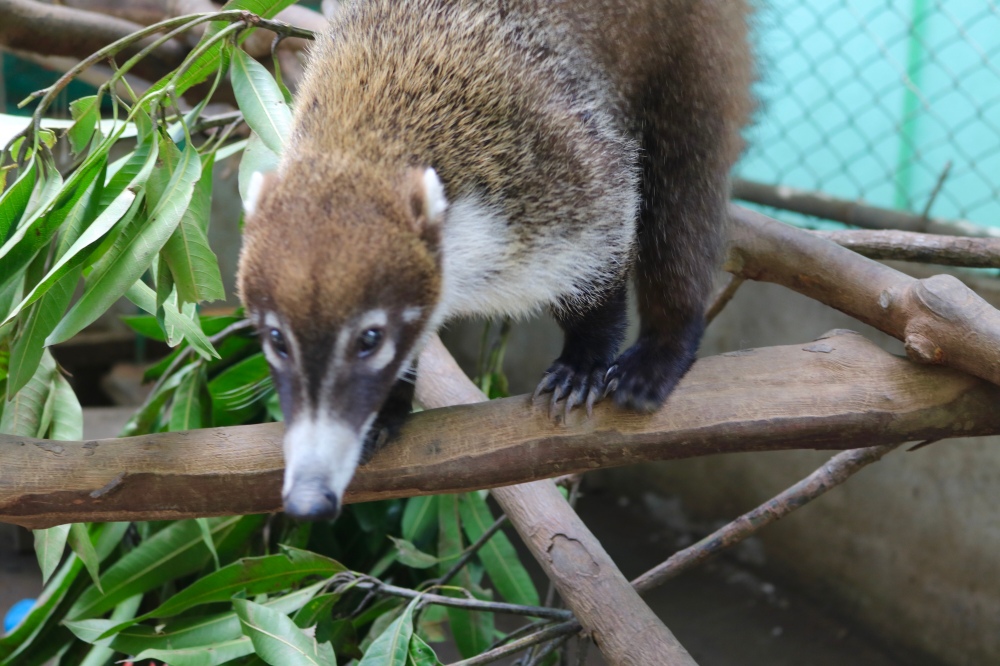
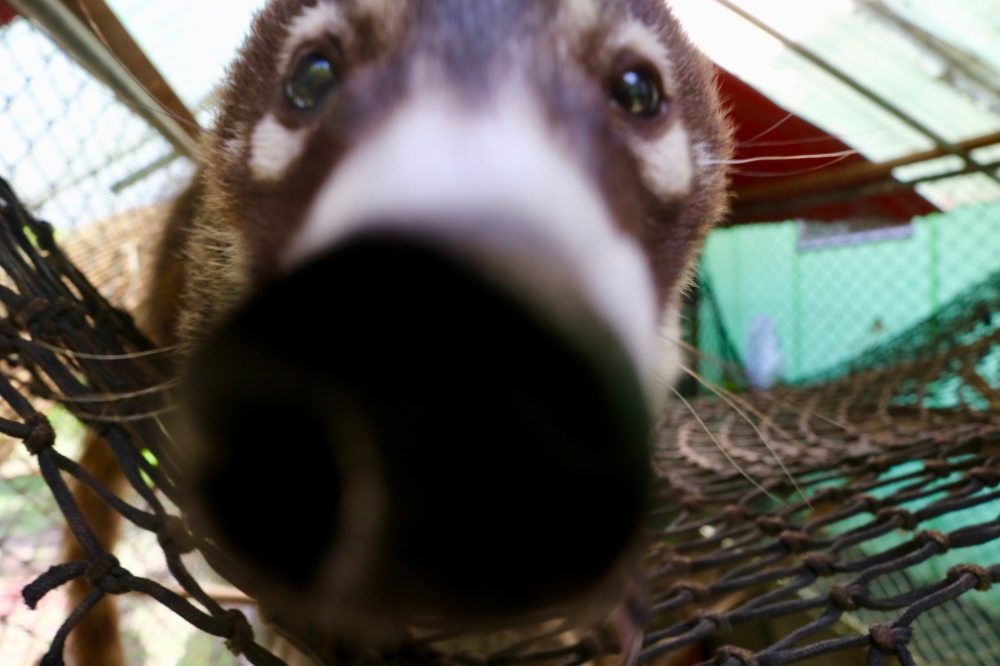
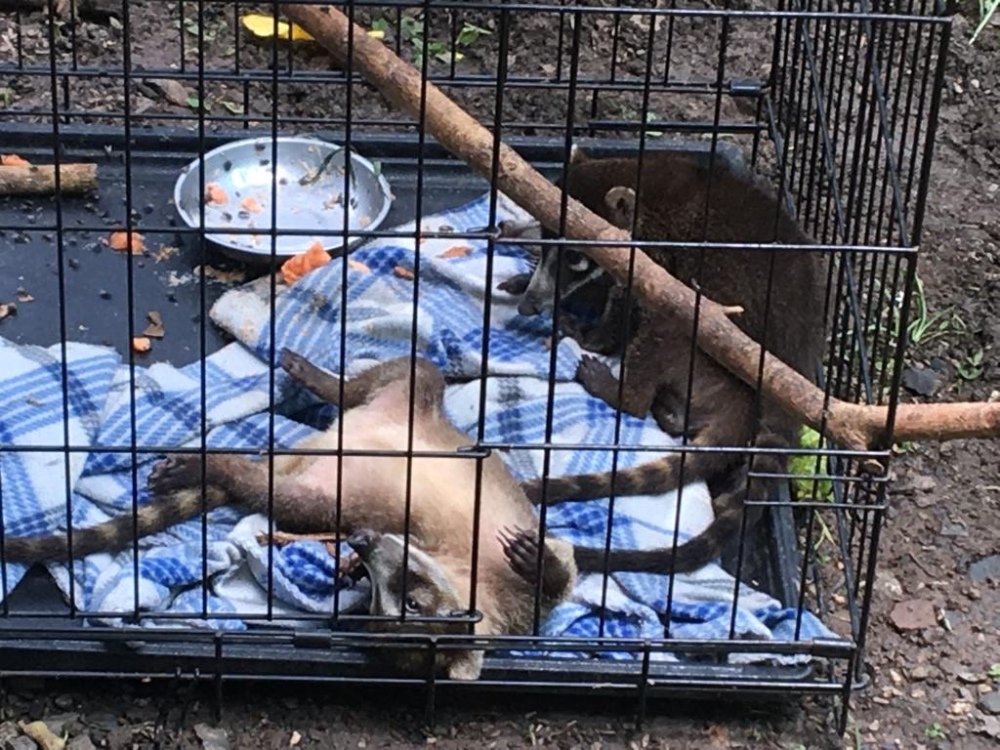
Yes. They are adorable. And I loved cleaning them it because they’re funny to watch. But cleaning them was the most time consuming task as they had to be removed from their cages and the bars hosed, scrubbed and disinfected vigorously. They also developed some skin issues so on a few occasions Shanon and I had to bathe them which they hated! And those claws? They don’t retract. We had many coati flesh wounds at the end of bath time!

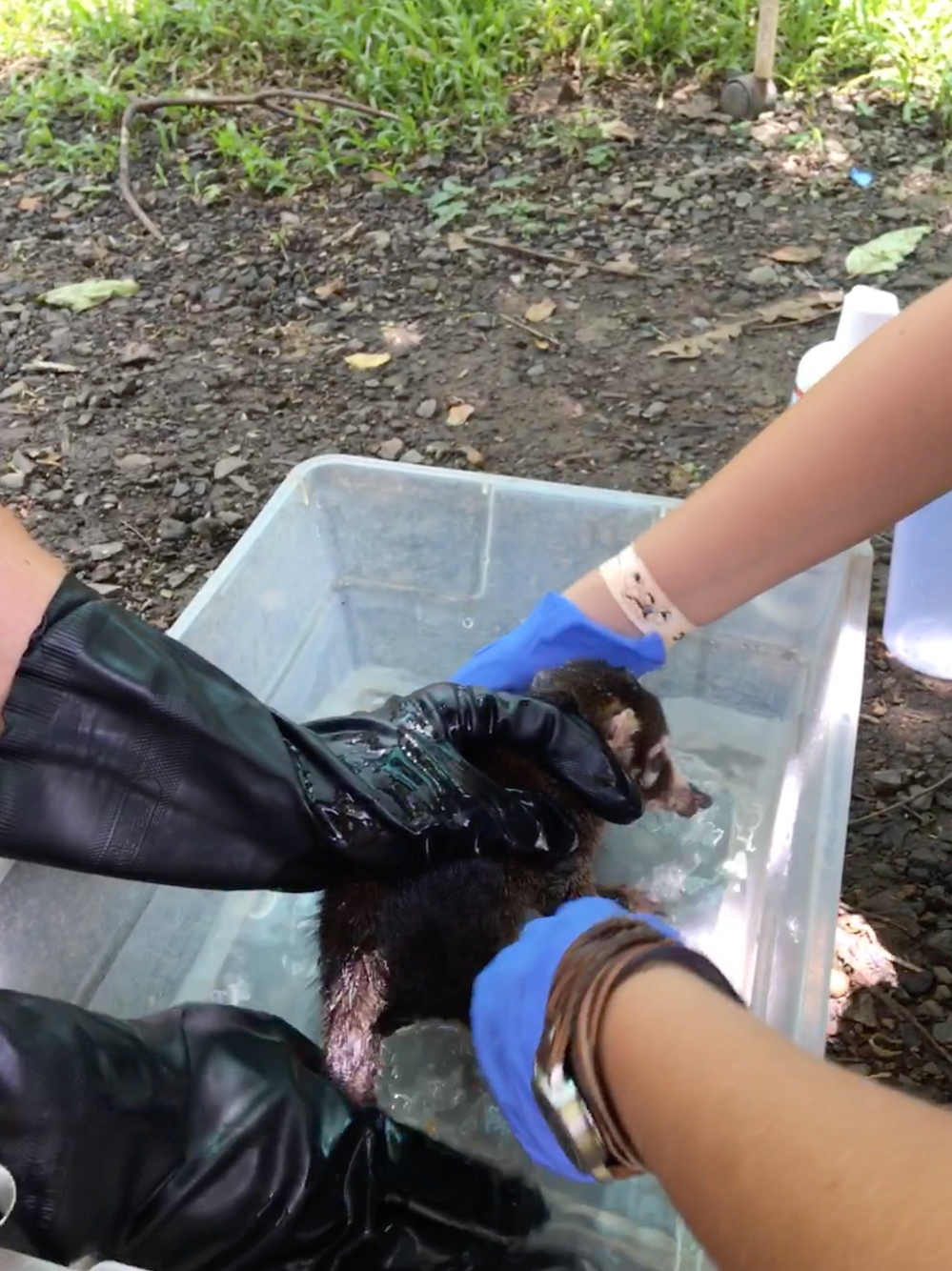
The Monkeys
There are 3 different species of monkey housed at the Rescue Centre, all of which have a turbulent past with humans and, of course, cannot be released. This was the first time we were able to work with howler monkeys, the only species we were able to enter the enclosure with. We had to wear masks to prevent spread of zoonotic diseases, and they generally didn’t seem bothered by us. A huge contrast to working with the monkeys at the centre in Peru where they jumped all over us each time we went in, the disconnect from humans was a very pleasant surprise.
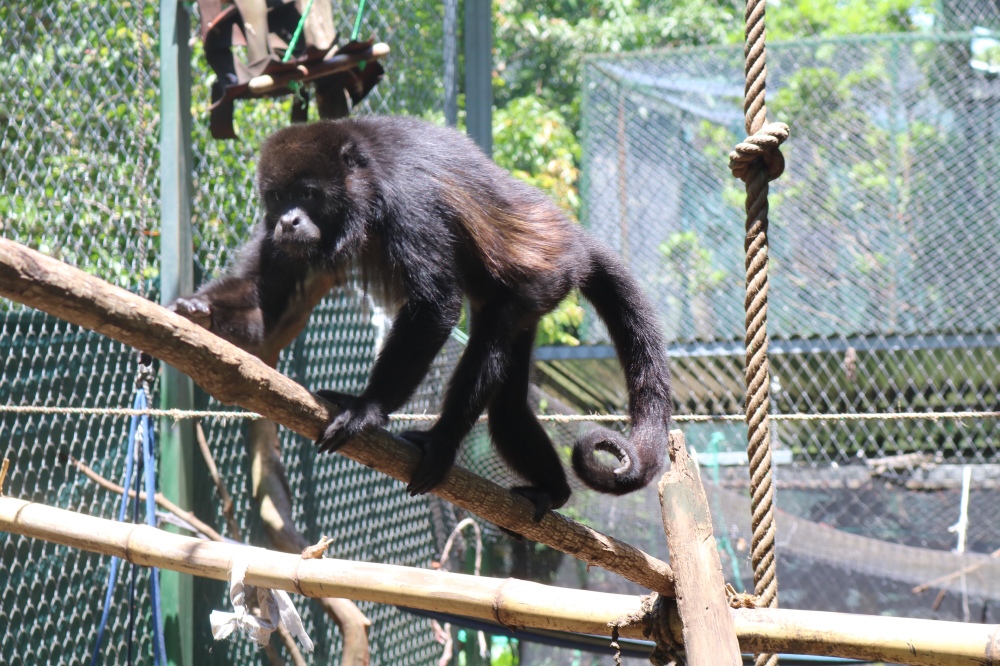
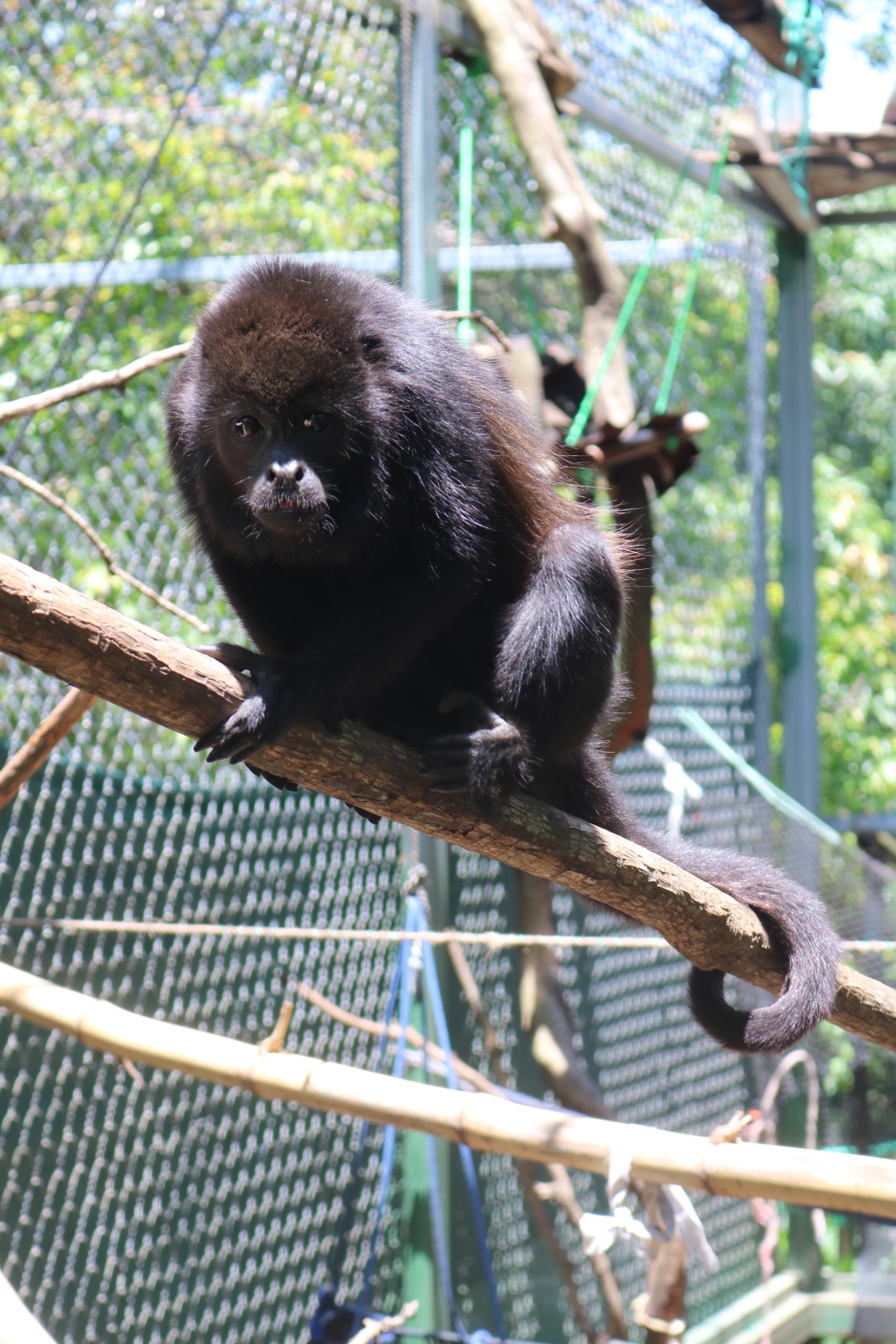
The white faced capuchins were hilarious to watch, especially young male Prince who really wore his heart on his sleeve, his facial expressions were brilliant!

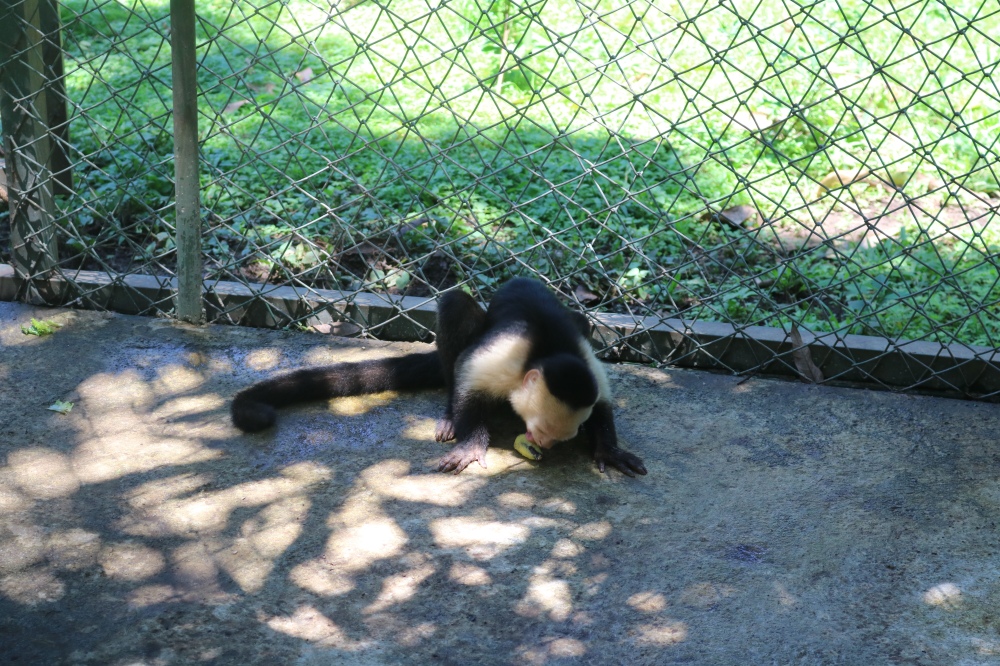
We were able to get up close with one female Luna after she was spotted acting quieter than usual and shaking her head a lot. Andrés decided one afternoon to sedate and examine her. Sedation was easy, she held her hand out to him throw the bars of the enclosure, he took her hand and injected her in the bicep. Within a minute she was sedated, we took her to the hospital where I hooked her up to the multiparameter and revelled in veterinary anaesthesia, a subject I was clearly missing having not worked in a veterinary environment for so long! We examined both her ears but could not find anything, so cleaned them out and gave her an injectable painkiller just in time for her to wake up.

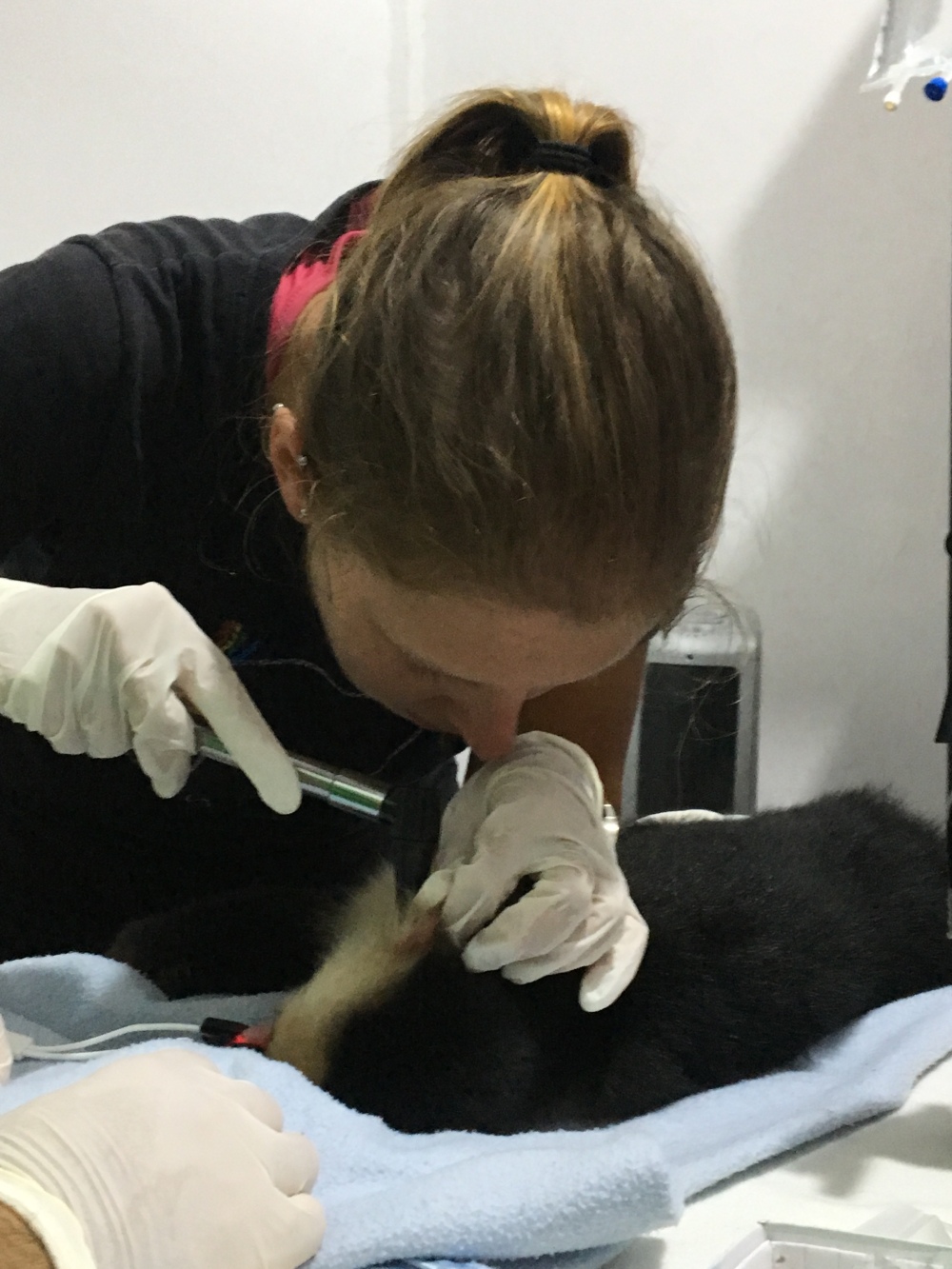
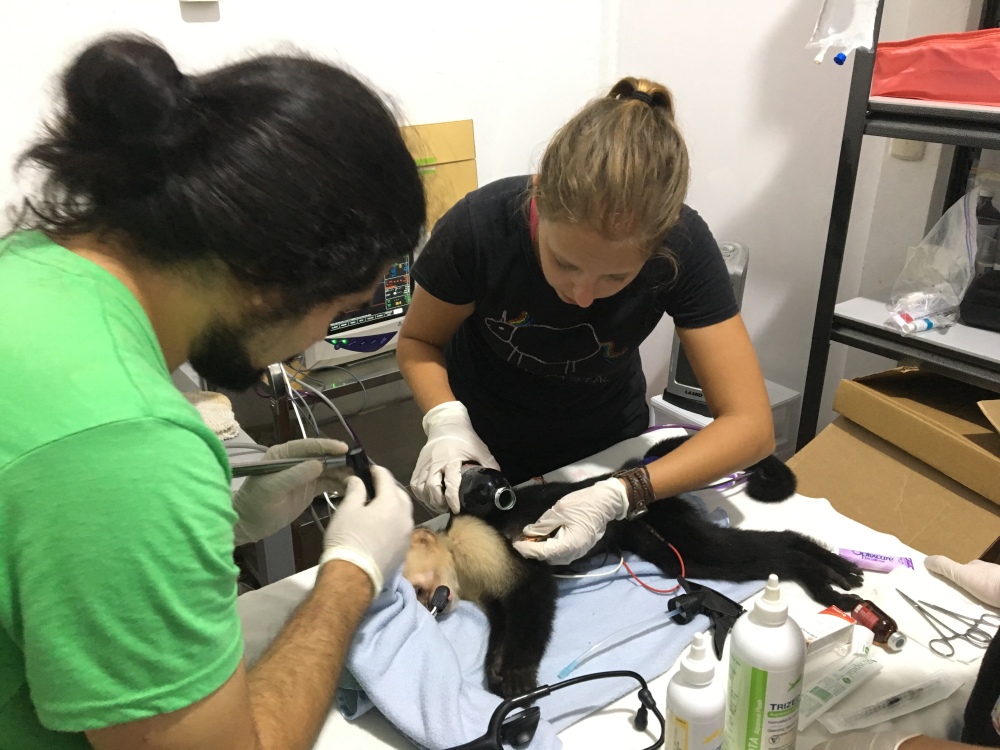
Last were the spider monkeys. Rather than walk in to their enclosures to feed them like we had in Peru, there was a safety system in place here to avoid contact with them. Whilst the spider monkeys had been raised by humans, they had been successfully detached and now had a troop led by alpha male Gandhi who was, for want of a better word, terrifying. He would try and grab volunteers through the enclosure bars, and was incredibly strong if he succeeded.
This became more evident when Andrés wanted to sedate and examine him one afternoon. Instead of handling and injecting through the bars like he had with Luna, he had to sedate Gandhi using a blow dart. Even this was not an easy task, and it took a good 20 minutes before he could get a clear shot as Gandhi knew exactly what was going on and kept trying to grab the blow dart pole. Once he was down we had to act quickly, whisking him to the clinic where Shanon monitored him. Andrés performed a head to tail examination and drew blood, and that’s about as far as we got as after just 20 minutes (despite a stonking great dose of Ketamine!) he began waking up, gripping my arm with his prehensile tail. Recovering Luna was an easy task, but recovering Gandhi was like being in a kennel with a lightly sedated aggressive dog – I did not want to be anywhere near him and knew he was unpredictable, especially in this state. Thankfully all went well, and his blood results all came back normal.

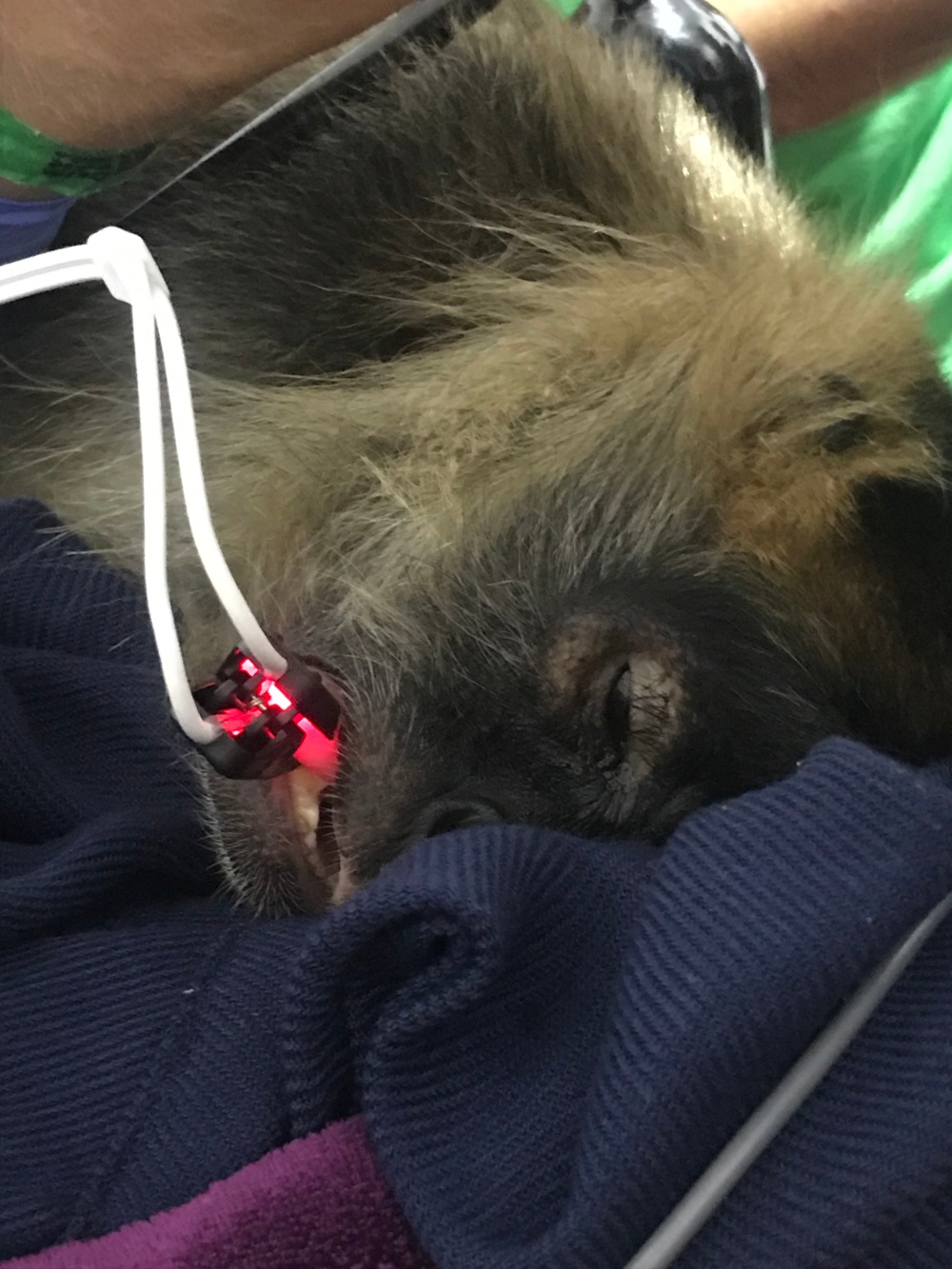

Ninushka was an exception when it came to the monkeys. She very much an old lady, and didn’t get on with the rest of the troop so is living out her days in a separate enclosure. Ninushka LOVES people, and she’s the only monkey there they encourage interaction with as she was raised by humans and craves social interaction with them. She’s very sweet and took a particular shine to Shanon, so he would visit her whenever he had a chance so she could groom him!
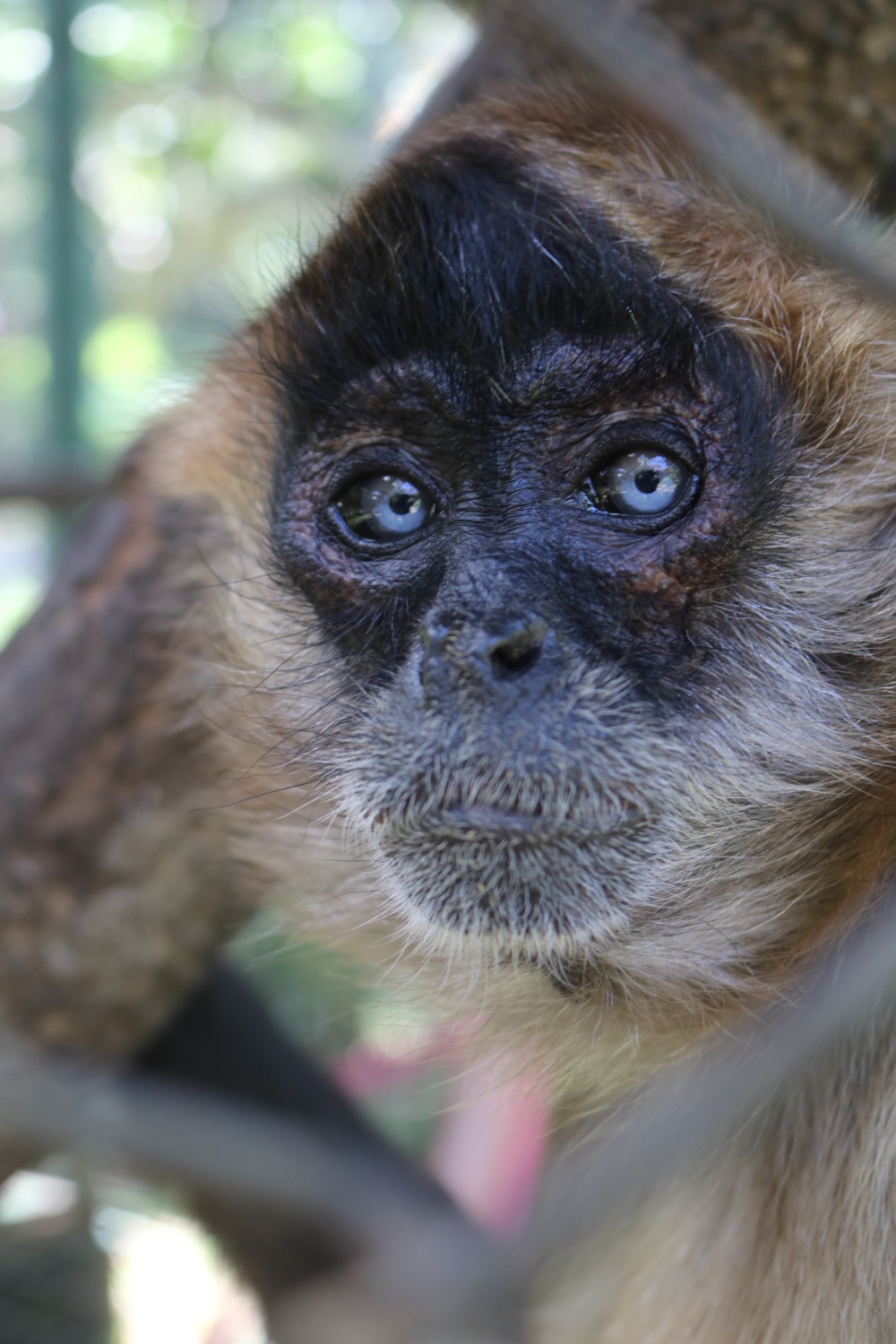
The Raccoons
The Trash Panda. These guys are closely related to dogs, and their super cute faces makes them irresistible to people as pets. Thanks to an increase in pet raccoons on social media they are become common, but this is not a good thing as they have not had the benefit of thousands of years of domestication like dogs. There are 2 adult raccoons at the centre – Rice and Beans – whom are adorable but are destined to life in a cage after someone tried and failed to keep them as pets. They’re fascinating creatures, and eat just about everything. One of my favourite activities was watching them forage for maggots or fish that we had caught on the property, using their tiny hands to feel around and munching down on what they managed to catch.
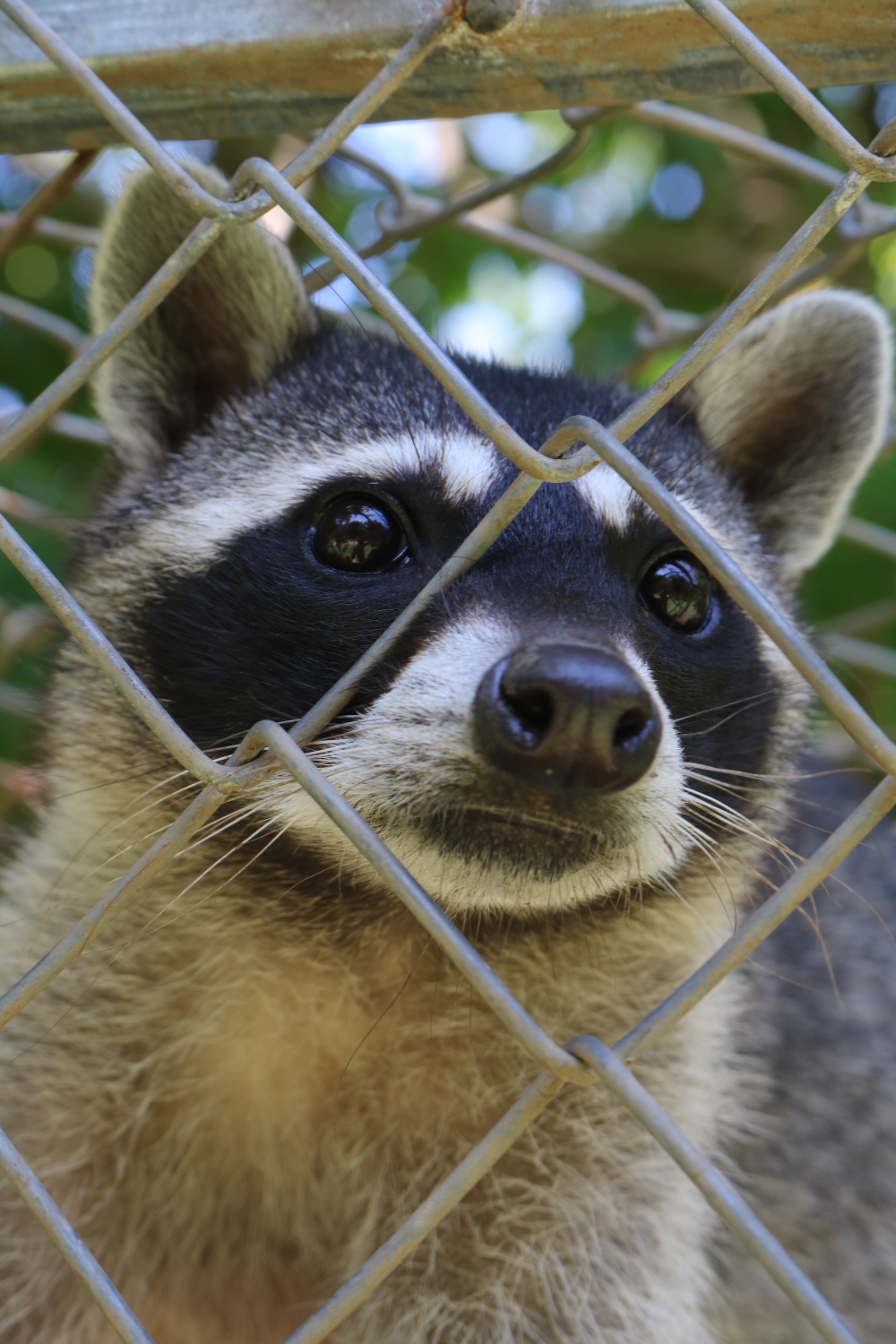
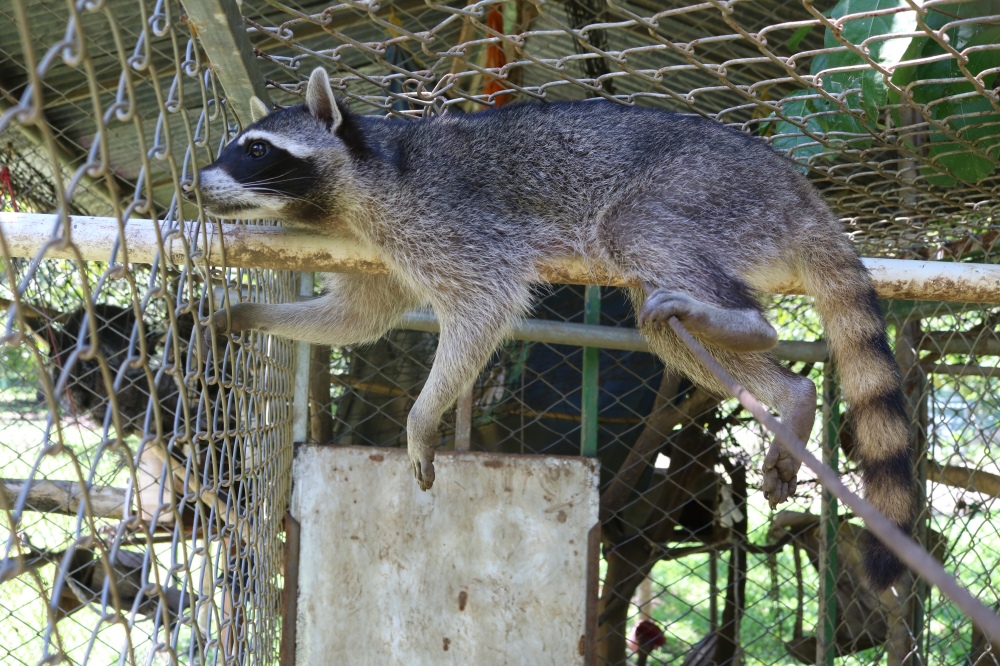
But my favourite raccoon? Wendy.
I’m not sure on her history, but she needed regular feeding throughout the night (rice milk, if you’re interested!) and we had just started taking her outside for walks before we left the centre. She was becoming a little too used to people, she would bound after me like a puppy and play with my feet, but I hear she has now been moved to an outside enclosure as she has grown significantly, and human contact has been cut so she can one day be released.

The Kinkajous
I wouldn’t be surprised if you haven’t heard of this marsupial, I certainly hadn’t! But they’re incredible creatures. Mainly nocturnal, they eat fruit and insects, and are also called “honey bears” as they use an incredibly long tongue to retrieve honey from hives. They mainly live in trees, using a prehensile tail, non-retractable claws and feet that can rotate 180 degrees to move around.
Being nocturnal we saw very little of them, but they are adorable nonetheless!
